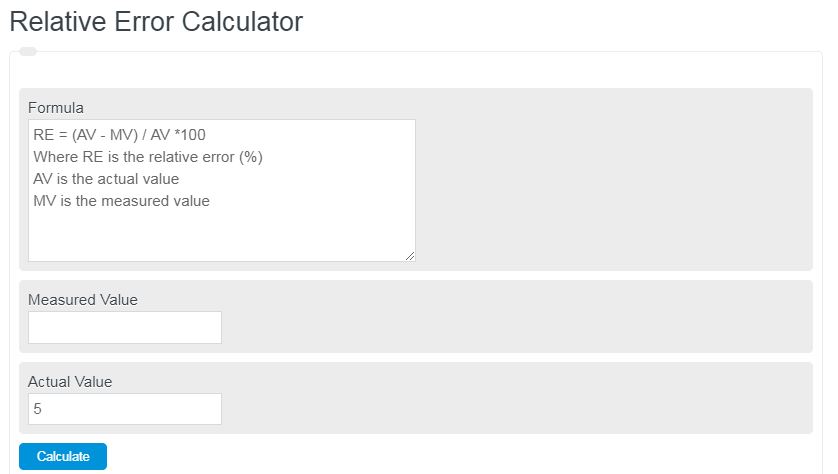Enter the measured value and actual value into the calculator below to determine the relative error (%) and the absolute error. This calculator can determine any value given the other variables are known.
- Percent Error Calculator
- Percent Yield Calculator
- Point Estimate Calculator
- Sampling Error Calculator
- Greatest Possible Error Calculator
- Max Error Calculator
Relative Error Formula
RE = |AV - MV|/ AV *100
- Where RE is the relative error (%)
- AV is the actual value
- MV is the measured value
To calculate relative error, subtract the measured value from the actual value, divide that result by the actual value, then multiply by 100.
What is Relative Error?
As is the case with the standard error, the relative error is a measure of how close a measured value is to the true theoretical value.
In the case of chemistry, this could be the measured mass of the actual mass of a reaction.
How to calculate relative error?
The following is an example problem for calculating the relative error in an experiment or set of data.
First, determine the theoretical value the experiment should yield. For this example, we are going to assume that we are analyzing a chemical reaction that is supposed to yield a certain mass of a product.
In this case, the expected mass yield is 20 grams.
Next, perform the chemical process, and measure the actual mass that was yielded from the reaction.
For this problem, the actual mass is measured to be 19 grams.
Finally, calculate the relative error using the formula above.
RE = |AV – MV|/ AV *100
RE = |20 – 19 |/ 20 *100
RE = 5%
Relative vs Absolute Error
Relative and absolute errors are both measures of the variation in a set of data between an expected value and the actual outcome.
In the case of absolute error, this is simply a measure of the absolute difference between the expected value and the measured value.
In the case of relative error, that absolute difference is compared to the expected value in terms of a percentage of variation.
Relative Error Properties
There are several properties of relative error that are used to better understand the variation in data.
For one, the relative error is always positive. This is because the relative error uses the absolute value of the difference between the expected and true outcomes.
Absolute values, as we know, are always positive, and therefore, so is the relative error.
Another property of relative error is that it’s the absolute value of the percent error. In other words, the difference between percent error and relative error is that percent error can be negative while relative cannot.
Can relative error be greater than 100%?
In some instances, a relative error can be greater than 100%.
For example, if you have a theoretical value of 10 but the measured value comes out to be 25, the formula calculates the relative error as |10-25| / 10 *100 = 150%.
FAQ
The relative error is a measure the difference between an expected or theoretical outcome and the actual outcome that occurred.
